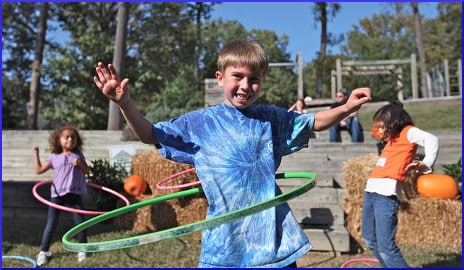
One of the big questions is how to get kids moving, and one answer that Childhood Obesity News has looked at is animal-assisted intervention — in other words, romping with dogs, which has succeeded in inspiring children to increase the amount of physical exercise they engage in. It even works with grownups.
A 2006 study of Canadian dog owners found that they walked almost twice as much as people who don’t own dogs. Although animal companionship can connect with the deep implicit motives that cause people to get up and move, that one possibility is not appropriate or applicable to everyone.
Tufts University grad student Christina Zagarino pioneered another method, and the easiest way to see what that’s all about is to check out the Big Top Fitness channel on YouTube. A child development major, Zagarino worked as an arts administrator, running circus camps for 7- to 11-year-olds, who got to interact with actual circus performers. Reporter Sam Baltrusis, writing for the Somerville Patch, quoted the young educator about the genesis of her idea:
The kids would spend five to eight hours a day working on circus skills and then they would share what they learned in a presentation on Fridays for parents and friends. I noticed that these kids were exercising and having a good time and I had the realization that the circus is very powerful. I started to think about how I could harness circus to promote physical engagement with children.
It was important for this motivation method to engage children across the socioeconomic spectrum, and in order to reach them earlier, Zagarino designed the Big Top Fitness program to appeal to kids from 3 to 5 years old (although of course older kids continue to enjoy the program too).
Another offbeat approach to creating and maintaining interest in exercise is the revival of the hula hoop, which has been around for decades and has made a comeback in slightly different form. Rather than the traditional hollow plastic tube, many hula hoops are now slightly weighted. Betty Shurin discovered that if the hoop has a bit of heft, it’s easier for the user to keep it circling.
Additionally, resistance created by adding the slight weight seems to help sculpt and reshape the body part the hoop spins around. Meanwhile, the core muscles — abdominals and obliques, as well as the muscles of the backside and thighs — are constantly contracting in a push-pull pattern that many exercisers find remarkably effective.
Shurin’s program borrows from yoga and tai chi techniques, improving the mind-body connection and relieving stress. At the same time, it’s rigorous exercise that improves both muscle tone and cardiovascular health, while remaining low-impact and preserving the integrity of the joints. Shurin says:
The hoop is your dance partner. You are creating new muscle as you allow the hoop to move around you and allow yourself to be moved by it…. It also burns 100 calories every 10 minutes. That’s as much as running on a treadmill — and a lot more fun.
The informational page shares the five workout tips that makes hula hooping all that it can be. But why is it so important to have a variety of exercise alternatives? Because, experts say, the availability of a menu of activities from which to choose is vital to maintaining interest and motivation.
Your responses and feedback are welcome!
Source: “Motivation,” NYTimes.com, 03/11/14
Source: ” ‘Big Top Fitness’ Uses Circus Skills to Combat Childhood Obesity,” Patch.com, 05/16/11
Source: “Hoop Your Way to Weight Loss: Top 5 Tips from a Hoop Workout Expert,” Gaiam.com, 2011
Image by Tom Woodward

 FAQs and Media Requests:
FAQs and Media Requests: 











